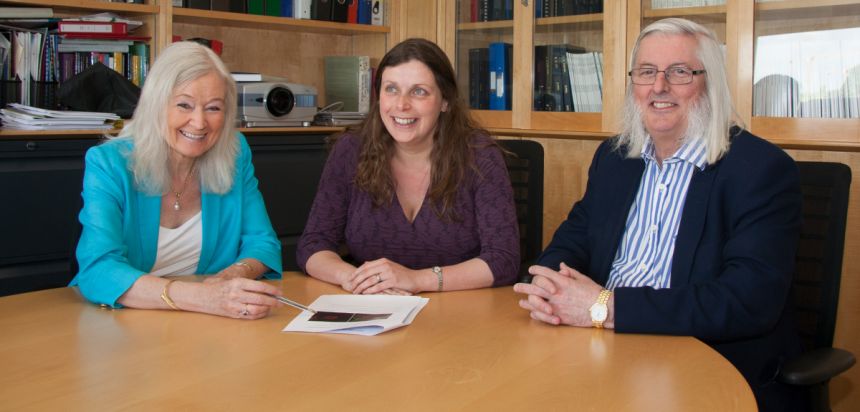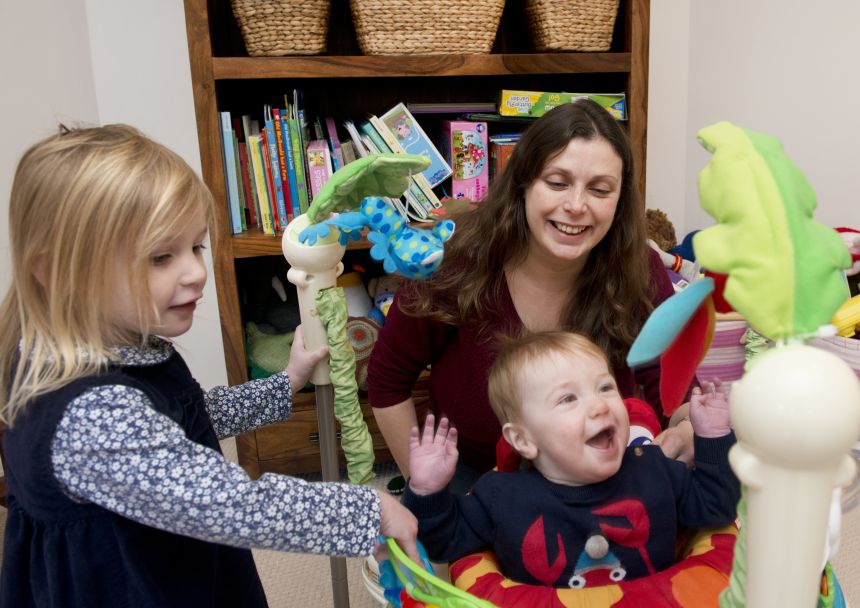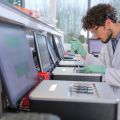Women in science series: Meet one of Oxford's most successful entrepreneurs
As Associate Professor of Organic Chemistry, a mother of two and one of Oxford University’s most successful entrepreneurs, developing both the spinout companies MuOx and OxStem, Professor Angela Russell wears many hats. She met with ScienceBlog to discuss the progress of women in science in the 21st century, her journey from academia to a successful business woman and her advice to anyone following in her footsteps.
What does your work in Organic Chemistry involve?
I run an academic research group aiming to develop new drugs to treat devastating degenerative diseases like Alzheimer’s and heart failure. The technologies we develop are helping us to answer fundamental clinical questions and understand how different substances affect regeneration processes in the human body. Our work is incredibly rewarding and has the potential to positively impact millions of peoples’ lives.
 OxStem founders Professor Dame Kay Davies, Professor Angela Russell and Professor Steve Davies
OxStem founders Professor Dame Kay Davies, Professor Angela Russell and Professor Steve DaviesHas becoming an entrepreneur always been a goal for you?
I always thought I would be a pure academic scientist, so the business side of things was totally unexpected. Often when you make a scientific discovery the most exciting part of the project is seeing it applied, but it easy to become removed from the development process in academia, and, it got me thinking why not just do it myself?
How did your journey into science commercialisation evolve?
I have co-founded two successful Biotech companies and both evolved quite organically. Mentorship has been key. Professor Steve Davies in particular has been a huge influence on my career and a co-founder of both MuOx and OxStem. As an entrepreneur himself, he has always encouraged me down the road of the commercialisation of science.
How did you go about commercialising your research and developing a spinout company?
MuOx (Muscle Oxford) built on a longstanding collaboration with Professor Dame Kay Davies, looking for a new treatment for Duchenne Muscular Dystrophy. Our original findings had led to the formation of VASTOx (now Summit Therapeutics plc) who developed the drug ezutromid into clinical trials. We wanted to discover new drugs that could improve on ezutromid’s effectiveness and went back to designing new substances that took the original research to the next level; MuOx.
Often with spinout development selling your product can be a real challenge, but our ongoing relationship with Summit meant they bought us very quickly. The company was spun out in 2012 and bought for five million pounds, by Summit in 2013. We continue to run an extremely important collaborative research programme with Summit developing these new drugs for Duchenne Muscular Dystrophy.
The technologies we develop are helping us to understand how different substances affect regeneration processes in the human body. Our work is incredibly rewarding and has the potential to positively impact millions of peoples’ lives.
What was the biggest learning curve from the development?
Building a strong case for product development that can be easily communicated to anyone - scientists, investors and general public alike is not easy. But if you don’t get it right, you won’t get the investment. As scientists, we get used to talking to each other in scientific code, but it’s just jargon to anyone else. People can’t support or engage with something they don’t understand, so I had to learn quickly how to communicate to people with varying science knowledge, like patients and the general public. You have to build an exciting case and believe in it yourself: ‘not only is this exciting science, but we can deliver on it and change people’s lives.’ If you don’t believe in your product why should anyone else?
How did OxStem evolve?
MuOx proved that we could translate science effectively, and it gave me the confidence to go for it on a big scale with Oxstem, which was effectively MuOx 2.0. It is exactly the same premise, a company developing drugs to treat diseases. But where MuOx focused specifically on muscle degenerative disease, OxStem aims to develop a platform to treat any degenerative or age-related disease.
Was building the company very different the second time around?
Oxstem isn’t a single company, it is an umbrella company, and we spinout successful daughter subsidiaries, each with a different disease focus – four so far. As an academic research development, it has been hard and time consuming to communicate the value of this structure to university stakeholders. We had to outline the structural benefits and challenges, such as how the model could work within existing financial structures, management of intellectual property and so on. It took a long time, but we achieved our goal, and in May 2016 we hit our £17 million target needed to get the company off the ground.
 Professor Russell co-founded OxStem, the company is currently working to develop a regenerative treatment that could reverse the symptoms of Alzheimer's. Photo credit: OXSTEM
Professor Russell co-founded OxStem, the company is currently working to develop a regenerative treatment that could reverse the symptoms of Alzheimer's. Photo credit: OXSTEMProfessor Russell co-founded OxStem, the company is currently working to develop a regenerative treatment that could reverse the symptoms of Alzheimer's. Photo credit: OXSTEM
What was the biggest challenge you faced setting up a spinout?
Getting people to believe in your idea in the early stages is really difficult, particularly with funders. Investment is essential to progressing opportunities from lab experiments, to something that will be of benefit to patients in the long run. It takes a lot of time and patience and you have to be up front with people, making sure that they understand what they are getting into. Yes it is a lucrative investment opportunity, but there are risks.
 Professor Russell playing with her two children
Professor Russell playing with her two childrenWhat advice would you give to someone looking to commercialise their research?
Identify a clear market need for your product, make a clear development plan and a list of reasons why you are the only one that can deliver on it. That is the way to be successful. Being actively involved in progressing your research is so rewarding. If you truly believe in your idea, this is the route for you.
Generally getting government or charity funding for discovery science is straight forward, but doing so for an idea that you want to translate into a research led, spin-out is not so easy; dubbed the “valley of death”. You have to have proof of concept, and show that your idea is going to work.
What projects are you currently working on?
The bulk of my work focuses on the development of new drugs to tackle degenerative and age-related diseases. For instance in collaboration with Professor Francis Szele we are looking at treating diseases like Alzheimer’s and other neurodegenerative conditions and how symptoms can be reversed. A disease like Alzheimer’s is characterised by the progressive loss of neurones in the brain, and we are working to develop a regenerative treatment that will replenish these neurones, reversing the symptoms of the condition in the process. It will make a tremendous difference to people’s lives. If all goes to plan, we will be ready to run a clinical trial in the next three to five years.
You have to build an exciting case for your product, and believe in it yourself. If you don’t believe in it why should anyone else?
Has being a woman in science posed any specific challenges for you?
I have never been discouraged or made to feel that I can’t achieve things because I am a woman. Nor have I ever felt it was an advantage either. I think that is really important. We can’t solve gender bias against women, by deflecting it to men. We have to create an environment where it is better for everybody. I am heavily involved in the Athena SWAN Charter, self-assessment process, and it’s not about creating more opportunities for women, but for everybody, and achieving equality across the board.
How do you think these opportunities can be created?
I think we have to change the working culture, and focus more on valuing people for what they contribute, not how long a day they work. In the past there was a more blinkered view that a brutally long working day was the only way to succeed, which made managing a family and a career almost impossible, but that is changing.
We can’t solve gender bias by deflecting it to men. We have to build an environment that is better for everybody. Not just creating more opportunities for women, but achieving equality across the board.
What motivated you to become a scientist?
My dad was always supportive of my ambitions. When I was 14 he told me ‘you’ll never be happy with a desk job.’ He was right. I’ve always been driven by a desire to carry out research for the betterment of human health. Chemistry was a subject I absolutely loved at school and saw as fundamental to all science because it underpins and impacts so many other disciplines, including medicine.
What advice would you give to someone embarking on a career in STEM?
The decisions that you make at the beginning of your career are important, and can impact your whole future, so try and think long term wherever possible. Everyone makes mistakes, but recognising when you aren’t on the right track and correcting it quickly makes it easier to stay on course. I came to Oxford to study Biochemistry, but realised quickly that it wasn’t for me. Two weeks before my first year exams I told my tutor I wanted to change to Chemistry. I flipped straight into the second year of a Chemistry degree, and almost gave my tutor a heart attack, but it was exactly the right decision for me.
If you hadn’t been a scientist what was your plan B?
I would have been a chef. I actually think chemists and chefs have a lot in common. They experiment with flavour combinations and we scientists cook up drugs that we want to use for clinical use. There is nothing more rewarding than cooking a nice dinner and watching your children tuck in.
 In her spare time Professor Russell enjoys cooking for her family, and has found parallels between chemistry and cooking. Chefs experiment with flavour combinations, while scientists cook up drugs for clinical use. Image credit: SHUTTERSTOCK
In her spare time Professor Russell enjoys cooking for her family, and has found parallels between chemistry and cooking. Chefs experiment with flavour combinations, while scientists cook up drugs for clinical use. Image credit: SHUTTERSTOCK
In her spare time Professor Russell enjoys cooking for her family, and has found parallels between chemistry and cooking. Chefs experiment with flavour combinations, while scientists cook up drugs for clinical use. Image credit: SHUTTERSTOCK
 Oxford University retains top spot for spinout generation in the UK
Oxford University retains top spot for spinout generation in the UK
 Oxford launches new multi-disciplinary ZERO Institute
Oxford launches new multi-disciplinary ZERO Institute
 Researchers develop the world's first power-free frequency tuner using nanomaterials
Researchers develop the world's first power-free frequency tuner using nanomaterials
 New adaptable smart window coating could help heat or cool a home and save energy
New adaptable smart window coating could help heat or cool a home and save energy
 Oxford University contributed £15.7 billion to the UK economy in 2018/19
Oxford University contributed £15.7 billion to the UK economy in 2018/19